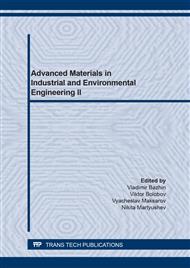p.15
p.21
p.28
p.35
p.41
p.47
p.55
p.61
p.68
Foamed Glassy Phosphate Materials for Biosorbents
Abstract:
The paper considers the applications of foamed glassy phosphate materials as carriers of biologically active substances. One of the advantages of phosphate materials is their ability to effectively support the life of microorganisms. This feature of phosphate glassy materials opens up the prospects for the application of microorganism strains - destructors of oil products to their foamed samples, that is, the creation of biosorbents for purification of water and soil from hydrocarbon contamination. The advantages of a biosorbent are explained by the high biological activity of microorganisms on the surface of foamed glassy phosphates and the possibility of active development of microorganisms with the simultaneous destruction of petrochemical contaminants. The use of biosorbent eliminates the problem of its utilization and regeneration, thus it is suitable for repeated use. The formation of porous glassy phosphate materials on the surface by the method of molecular layering of monolayer coatings allows obtaining chemically modified composite materials, which improves their performance characteristics such as strengthening the material structure with a simultaneous increase in the catalytic activity of biochemical processes.
Info:
Periodical:
Pages:
41-46
Citation:
Online since:
July 2021
Authors:
Price:
Сopyright:
© 2021 Trans Tech Publications Ltd. All Rights Reserved
Share:
Citation:


